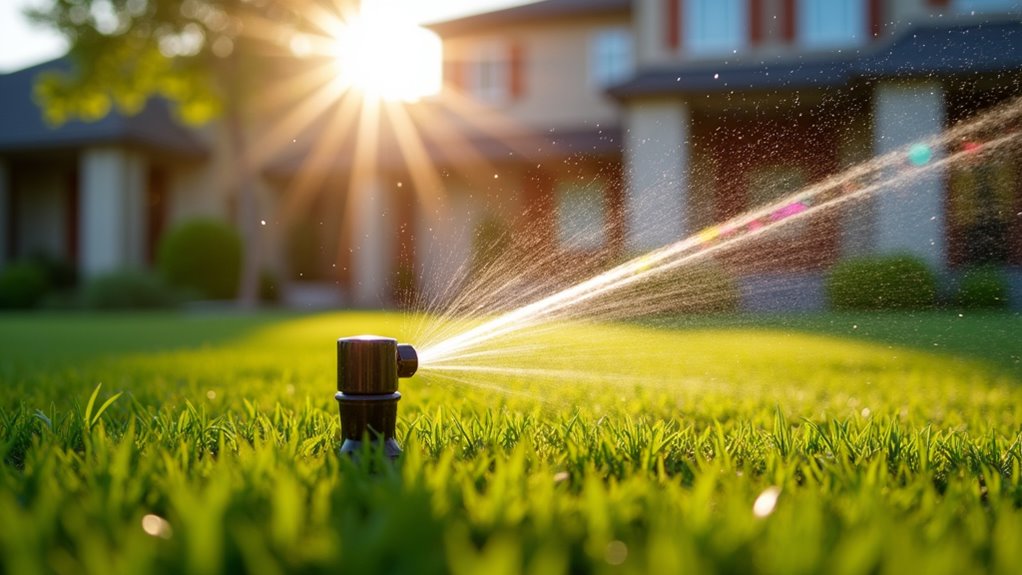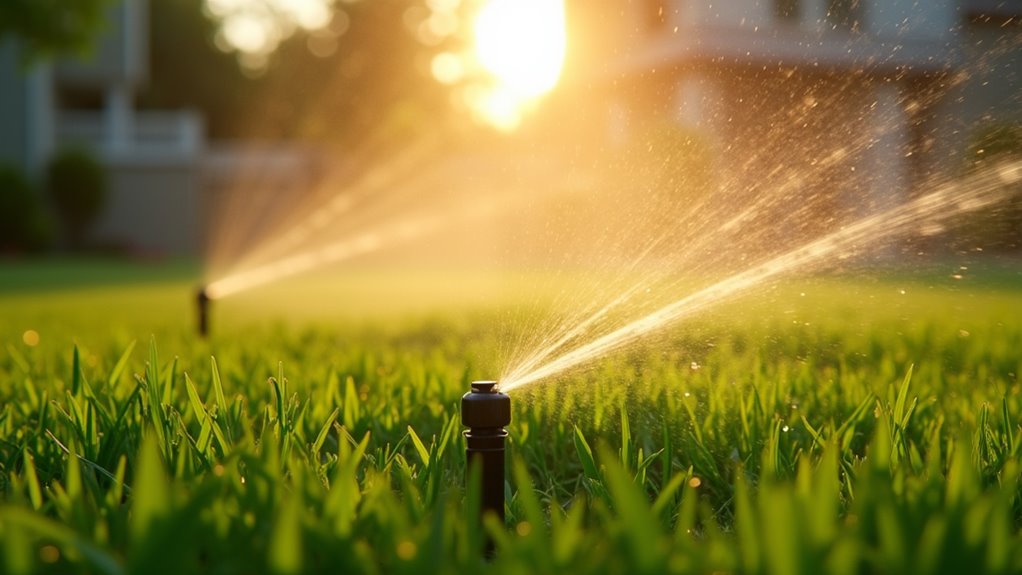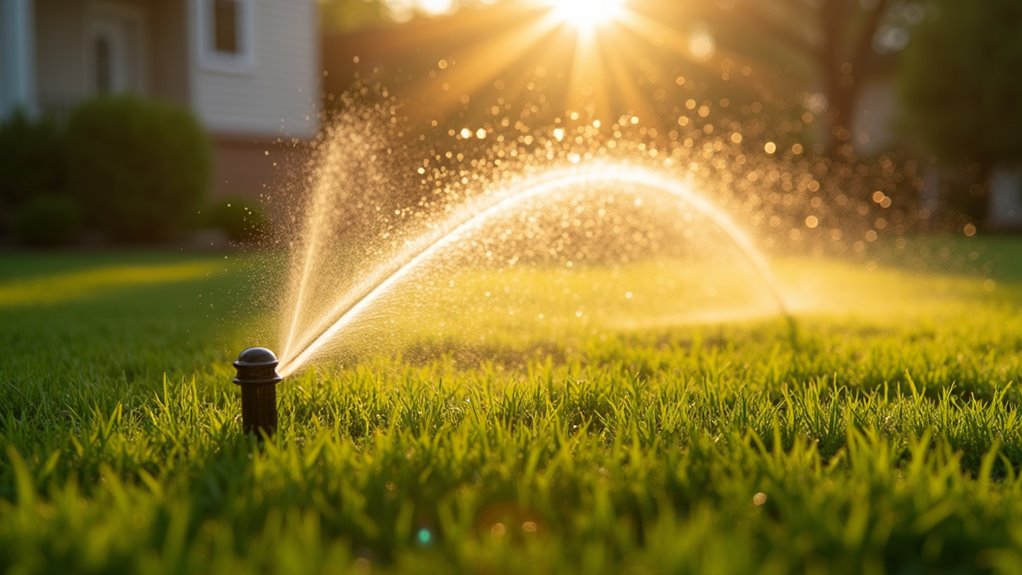Timing lawn aeration correctly depends on your grass type: aerate cool-season grasses in early fall or spring, and warm-season varieties in late spring to early summer. Wait until soil is moist but not soggy, following the 24-hour rule of watering the day before. Watch for signs like standing water, thatch buildup, and soil compaction. Avoid aerating during dormancy or extreme weather. The right timing guarantees maximum benefits while minimizing stress on your lawn.
Identify Your Grass Type – Cool Season vs. Warm Season Timing

Success in lawn aeration hinges primarily on understanding your grass variety’s growth cycle. Proper grass type identification allows you to target ideal aeration periods when your lawn can best recover and thrive.
Cool-season grasses (Kentucky bluegrass, fescue, ryegrass) develop deeper roots during fall when topgrowth slows. Aerate these varieties in early fall (September-October) or as a secondary option in early spring (March-April). Their seasonal adaptations make them vulnerable during summer’s heat.
Warm-season grasses (Bermuda, zoysia, St. Augustine) enter active growth during late spring through summer. Schedule your aeration when they’re vigorously growing typically late spring to early summer (May-June). Never aerate warm-season grasses during dormancy or you’ll risk permanent damage and weed infiltration.
Watch for Signs That Your Lawn Needs Aeration
How can you determine if your lawn requires aeration? Even with ideal seasonal timing, your lawn’s specific conditions dictate aeration necessity. Watch for clear lawn compaction signs that indicate diminished root system health and reduced nutrient absorption capacity.
- Standing water – Puddles that remain 24+ hours after rainfall indicate compacted soil preventing proper drainage
- Spongy feeling when walking on grass, suggesting thatch buildup exceeding ½ inch
- Difficulty inserting screwdriver 4-6 inches into soil without excessive force
- Thinning grass patches despite proper watering and fertilization, indicating roots can’t access nutrients
Don’t wait for severe symptoms to develop. Early intervention through strategic aeration prevents deterioration of soil structure and maintains strong root development, especially in high-traffic areas where compaction occurs most rapidly.
The Ideal Seasons for Aerating Different Lawn Types
 Cool-season grasses like Kentucky bluegrass and fescue benefit most from aeration during early fall or spring when they’re actively growing. For warm-season varieties such as Bermuda and zoysia, schedule your aeration in late spring through early summer when these grasses enter peak growth phases. Your regional climate greatly impacts timing decisions, requiring adjustments based on local precipitation patterns, temperature fluctuations, and soil conditions specific to your geographic area.
Cool-season grasses like Kentucky bluegrass and fescue benefit most from aeration during early fall or spring when they’re actively growing. For warm-season varieties such as Bermuda and zoysia, schedule your aeration in late spring through early summer when these grasses enter peak growth phases. Your regional climate greatly impacts timing decisions, requiring adjustments based on local precipitation patterns, temperature fluctuations, and soil conditions specific to your geographic area.Cool-Season Grass Timing
For ideal results, aerating cool-season grasses should be timed with their natural growth cycles. Cool season varieties like Kentucky bluegrass, fescue, and ryegrass experience strong root development during fall when soil temperatures remain moderate but air temperatures cool. This creates the perfect recovery environment post-aeration.
- Early fall (September-October) provides the best primary aeration window, allowing 4-6 weeks of growth before winter dormancy
- Early spring (March-April) offers a secondary opportunity as soil thaws and growth resumes
- Avoid summer aeration when these grasses are stressed by heat and drought conditions
- Never aerate during winter dormancy when recovery capability is minimal
Timing your aeration correctly guarantees your lawn can quickly repair and enhance the benefits of improved soil access, nutrient penetration, and reduced compaction.
Warm-Season Aeration Windows
Unlike their cool-season counterparts, warm-season grasses such as Bermuda, Zoysia, St. Augustine, and Centipede thrive in late spring and summer heat. You’ll want to aerate these lawns when they’re in active growth—typically late spring through early summer (May through July). This timing guarantees your lawn can recover quickly from the stress of aeration techniques.
For best results, schedule your aeration when soil temperatures consistently stay above 65°F. Don’t aerate warm season grasses during dormancy periods or you’ll risk weed invasion and slow recovery. In transition zones, wait until your lawn has fully greened up after winter dormancy.
If you’ve missed the primary window, a secondary opportunity exists in early fall, provided temperatures remain warm enough for continued growth before dormancy sets in.
Regional Climate Considerations
Because your regional climate greatly impacts ideal aeration timing, understanding your specific growing zone proves essential for lawn care success. Seasonal patterns across North America vary dramatically, requiring you to adjust your aeration schedule accordingly.
- Northern regions (zones 3-5): Aim for early fall (September) when cool-season grasses enter prime growth phase but before initial frost threatens recovery.
- Transition zones (zones 6-7): Schedule two aerations—spring (April) and fall (September)—to accommodate mixed grass varieties.
- Southern regions (zones 8-10): Time your aeration during late spring to early summer (May-June) when warm-season grasses actively grow.
- Coastal areas: Monitor humidity and rainfall patterns closely, as excessive moisture can compact soil faster, potentially requiring more frequent aeration.
Always check your local extension office for region-specific recommendations customized to your microclimate.
Soil Moisture Levels: The 24-Hour Rule Before Aerating

While preparing your lawn for aeration, soil moisture levels play a critical role in the effectiveness of the process. For best results, follow the 24-hour rule: water your lawn thoroughly one day before aerating. This timing guarantees soil is moist but not waterlogged, allowing aeration techniques to penetrate effectively.
You’ll know your soil moisture is ideal when a screwdriver slides easily 6 inches into the ground without resistance. If soil sticks excessively to your aerator tines, it’s too wet; if tines can’t penetrate more than 2 inches, it’s too dry. Proper moisture creates the perfect balance where soil cores extract cleanly without compaction.
Avoid These Common Seasonal Timing Mistakes
When homeowners aerate their lawns without considering seasonal factors, they often undermine the entire process. Your timing decision directly impacts root development, nutrient absorption, and recovery rate. Avoiding critical seasonal timing pitfalls will enhance your aeration benefits and prevent lawn damage.
The success of lawn aeration hinges not on the act itself, but on the timing of your seasonal approach.
Watch for these common seasonal errors:
- Spring aeration during seed germination – This disrupts natural growth cycles and wastes resources
- Summer aeration during drought conditions – Creates extra stress on already vulnerable grass
- Fall aeration too close to initial frost – Prevents proper healing before dormancy
- Winter aeration on frozen soil – Damages equipment and compacts rather than loosens soil
You’ll achieve ideal results by aligning your aeration schedule with your grass type’s growth pattern and avoiding these timing mistakes.
Coordinate Aeration With Other Lawn Maintenance Tasks
Enhance your lawn care efforts by strategically coordinating aeration with overseeding, as the fresh soil exposure provides ideal seed-to-soil contact for improved germination rates. You’ll achieve better results when you aerate shortly after mowing, ensuring the machine can penetrate more effectively into the soil surface without tall grass interference. When these maintenance tasks work in tandem, you’ll create a more efficient lawn care schedule while greatly enhancing the general effectiveness of each individual procedure.
Combine With Overseeding
Aeration creates the perfect opportunity to combine multiple lawn improvement tasks into one efficient operation. After punching holes in your soil with core or spike aeration methods, the exposed soil provides ideal seed-to-soil contact for overseeding benefits. This simultaneous approach enhances your lawn care efficiency while minimizing disruption to your yard.
When combining aeration with overseeding:
- Select grass seed varieties compatible with your existing lawn but offering improved drought or disease resistance
- Apply seed immediately after aerating while soil plugs are fresh
- Distribute seed at the recommended rate using a broadcast spreader for even coverage
- Water lightly but frequently (twice daily) for 10-15 days to encourage germination without washing away seeds
This strategic pairing reduces competition from existing grass while giving new seedlings direct access to nutrients, water, and sunlight.
Post-Mowing Aeration Benefits
Timing your aeration after mowing creates an excellent sequence for thorough lawn care. When grass is cut to an appropriate height (typically 2-3 inches), aeration tools can more effectively penetrate the soil surface without excess blade interference. This strategic sequencing reduces lawn stress by allowing the core aerator to access compacted soil zones with minimal resistance.
The post-mowing benefits extend beyond mere convenience. Freshly mowed lawns expose thatch layers more clearly, helping you target problem areas during aeration. Furthermore, shorter grass enables extracted soil cores to settle back into the lawn more efficiently, accelerating decomposition. For best results, mow your lawn 2-3 days before aerating this provides time for clippings to settle while maintaining the ideal grass height for maximum aeration effectiveness.
Regional Climate Considerations for Precise Timing
While general aeration guidelines exist, your specific geographic location considerably impacts the ideal timing for lawn aeration. Regional grass types respond differently to seasonal changes, and humidity levels affect soil compaction rates throughout the year.
- Cool-climate regions (Northeast, Upper Midwest): Aerate in early fall (September) when cool-season grasses enter their primary growth phase
- Transition zones (Mid-Atlantic, parts of Midwest): Schedule for late spring or early fall, depending on your dominant grass species
- Southern regions: Target late spring to early summer when warm-season grasses like Bermuda and Zoysia actively grow
- Arid Western regions: Time your aeration for early spring when soil moisture levels are naturally higher, reducing supplementary irrigation needs
Post-Aeration Recovery Periods: What to Expect
After selecting the ideal seasonal window for your region, understanding the recovery timeline becomes the next key planning factor. Most lawns require 2-4 weeks for complete recovery, with visible improvements in soil compaction occurring within the initial week. You’ll notice aeration holes remaining visible for 7-10 days before gradually closing as your grass begins to fill in these areas.
Your lawn’s health directly impacts recovery speed well-maintained turf bounces back faster than stressed grass. Expect slower recovery periods during extreme temperatures or drought conditions. During this recovery phase, root development accelerates below the surface even when visible progress seems minimal. To optimize healing, maintain consistent irrigation without oversaturating, apply a light top dressing, and avoid heavy foot traffic until your lawn shows clear recovery expectations have been met.
Weather Forecasting for Perfect Aeration Conditions
Checking weather forecasts at least 7-10 days before planned aeration helps you identify the ideal window for lawn treatment. You’ll want soil that’s moist but not waterlogged, ideally following light rain or irrigation 1-2 days prior to aeration. The most effective aeration occurs when soil temperatures remain between 50-75°F, ensuring both mechanical penetration and biological recovery proceed efficiently.
Monitor Long-Term Forecasts
Because successful lawn aeration depends heavily on soil moisture levels, you’ll need to monitor long-term weather forecasts before scheduling your aeration day. Tracking weather patterns weeks in advance gives you insight into ideal soil conditions and helps avoid wasted effort on poorly timed aeration.
- Check 10-14 day forecasts regularly during your region’s aeration season to identify perfect moisture windows
- Consider long term weather patterns that might indicate drought or excessive rainfall periods
- Use weather apps that provide soil moisture predictions and track seasonal climate changes in your area
- Document rainfall amounts for 7-10 days before your planned aeration date
This strategic approach guarantees you’ll select a timeframe when soil is neither waterlogged nor extremely dry—both conditions that greatly reduce aeration effectiveness and potentially damage your lawn.
Ideal Moisture Levels
Soil moisture stands as the single most vital variable determining aeration success. You’ll want soil that’s moist but not saturated—typically 24-48 hours after rainfall or irrigation. This goldilocks zone allows tines to penetrate 2-3 inches deep without soil sticking to equipment.
Test moisture levels by inserting a screwdriver into your lawn. It should slide in with moderate resistance. If it enters too easily, the ground is oversaturated; if it barely penetrates, delay aeration until conditions improve. Proper moisture retention after aeration helps grass recover quickly while maximizing nutrient absorption.
For severe soil compaction, slightly wetter conditions may be preferable as tines can better penetrate dense areas. However, never aerate muddy soil this causes more harm than good, potentially worsening compaction issues rather than resolving them.
Temperature Range Matters
While moisture creates the foundation for successful aeration, temperature conditions ultimately determine when your efforts will yield peak results. Soil temperature directly affects grass recovery and root development post-aeration. Monitor your local forecast to identify ideal temperature windows that enhance effectiveness.
- Cool-season grasses: Aerate when soil temperatures range between 50-65°F, typically in early fall or spring when roots actively grow
- Warm-season grasses: Wait until soil temperatures consistently stay above 70°F, usually late spring through early summer
- Avoid extreme temperature fluctuations: Schedule aeration at least two weeks before expected temperature swings to prevent stress
- Consider seasonal impacts: Fall aeration prepares cool-season lawns for winter, while spring/early summer timing benefits warm-season varieties
Always measure soil temperature 2-4 inches below surface for accurate readings rather than relying on air temperature alone.
Creating a Multi-Year Aeration Schedule for Lawn Health
For ideal lawn health, establishing a consistent multi-year aeration plan delivers superior results compared to sporadic treatments. Cool-season grasses typically benefit from annual aeration, while warm-season varieties may thrive with sessions every 2-3 years. Track your lawn’s response and adjust accordingly.
The multi-year benefits become increasingly apparent in seasons 2-4, as proper aeration frequency gradually improves soil structure and reduces thatch buildup. Create a simple calendar reminder system that accounts for your grass type, soil conditions, and local climate patterns.
Consider alternating between core and spike aeration methods across consecutive years for different soil benefits. Document your lawn’s response through photos or notes to refine your timing and technique, ensuring you’re maximizing the cumulative advantages of regular soil decompaction.



